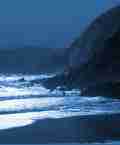 |
Search the site:

Walking Irelandís MountainsDONEGALI ran, covered with perspiration and panting with heat, to mount the topmost ridge [of Muckish]; and just as we arrived there... and began to feast on the immense vision of the earth and ocean beneath us, a vast murky cloud from the Atlantic, big with sleet and moisture, enveloped us as well as the whole top of the mountain as with a night-cap, and made every thing so dark, indistinct and dreary, that we could scarce see one another.The wildest and most spectacular mountains of this remote region of fine rocky peaks interspersed with some of less character are the North Donegal Highlands. These consist of three parallel south-west to north-east lines of mountains, each about fifteen kilometres/ ten miles long, a layout which makes looped walks a little difficult to plan. Of the three ranges, that to the north (unnamed on the maps), containing the strking quartzite scree-sided peak of Errigal 751 metres/ 2,466 feet) and the flat-topped Muckish (666 metres/ 2,197 feet) (routes 46 to 48, 60) is the most dramatic and spectacular. Errigal is the most symmetrical peak in Ireland and boasts the smallest summit; equally distinctive but in stark contrast is the large cairn-studded plateau of Muckish. These two peaks are connected by a fine range of hills cradling high-level lakes. It is a pity, however, that in an area of few forestry plantations, a large one here blocks direct access from the south-east to this central section of the range. The entire range forms the route of the east-west Glover Highlander, a marathon walk which takes place in September every year; a shortened version of this walk might be possible using the bus service which runs along the coastal road (N56). For this, the start of route 47 and the end of route 48 might be used. The middle range, the granitic Derryveagh Mountains, rises to the great hump of Slieve Snaght (678 metres/2,240 feet) (route 49) south-west of the awesome Poisoned Glen. Backing the bare and sinister walls of this glen and extending into the area to its north-east and south-west, are long, straight, parallel lines of low cliffs running across the range. Though slow to negotiate, they add spice to an already rugged and scenic area. The southern range, the Glendowan Mountains, is also granitic (for convenience, the name is applied to the whole line of mountains, not the smaller area designated on the Ordnance Survey maps). The lowest of the three, Glendowan's rolling wet moorland makes it of less interest than its northern neighbours. Most of the Glenveagh National Park (routes 50, 59) lies within the southern and middle ranges. The park, whose nucleus is a castle and a "chocolate box top" lake, contains a herd of red deer within a large area bounded by a deer fence. It can be crossed easily, but take care not to damage it. The next 'Donegal' extract can be found here : Part 2 Information extracted from Walking Irelandís Mountains: a guide to the ranges and the best walking routes by David Herman, published by Appletree Press.
|
[ Back to Top ]
All Material © 1999-2009 Irelandseye.com and contributors
